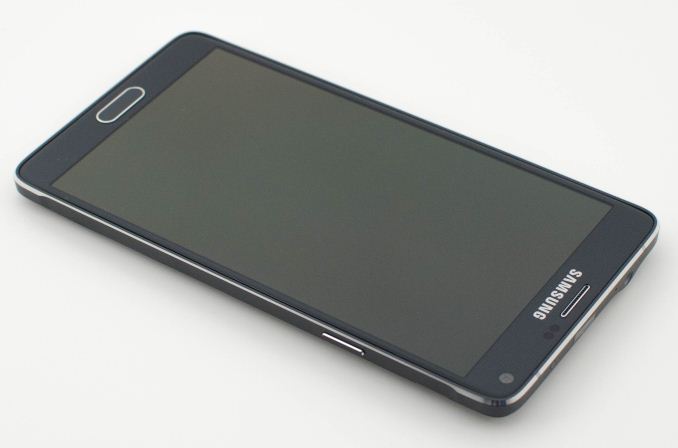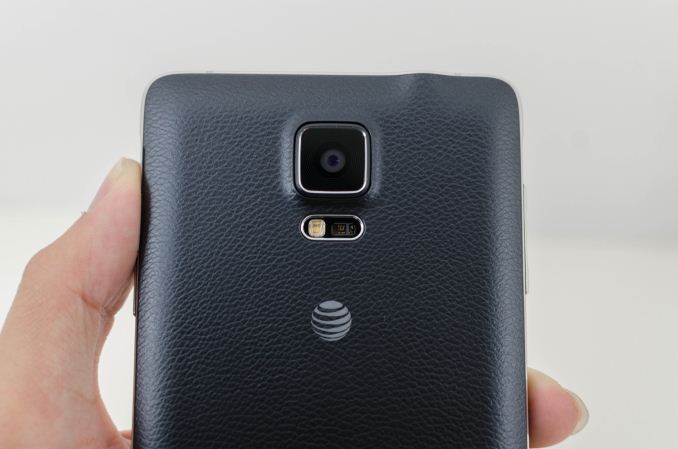The Samsung Galaxy Note 4 Review
by Joshua Ho on October 15, 2014 9:00 AM EST- Posted in
- Smartphones
- Samsung
- Android
- Mobile
- Galaxy Note 4
Final Words
The Galaxy Note 4 builds on the Galaxy S5 and Galaxy S5 LTE-A, but there’s still a lot to go over. We’ll break this down by section before coming to any real conclusions about this device. Based upon my time with the Galaxy Note 4, it’s clear to me that the most critical point of differentiation in the Galaxy Note 4 is the software experience. While other phones with TouchWiz can have similar features, it’s really a function of the hardware and additional feature support that comes with the Note 4 that makes the Galaxy Note more than just a big phone. The good news here is that Samsung continues to have a lot of great ideas in software, and many of the features tend to be quite helpful in nature. However, there’s a need to polish these features as the implementation tends to be rough around the edges. Overall, one shouldn’t have any significant issues with the software but Apple definitely has an edge in the polish department, even if the functionality isn’t as extensive.
The next key distinction is the display. The Galaxy Note is differentiated by its software, but defined by its display. It’s definitely big, and should be great for media consumption with its high contrast. More importantly, Samsung has continued to push better display calibration, brightness, and other areas where AMOLED was previously deficient. While there are still some issues with purple smearing and green tints to some level of grayscale, the AMOLED display is an equal to the 1080p display in the iPhone 6 Plus.
While the display defines the Galaxy Note 4 as a phablet, the design of the device itself is also important. To this end, Samsung has finally delivered a phone that feels as premium as its competition. While I do have some minor nitpicks regarding the design, on the whole it really is good enough that I don't have any real complaints. There are definitely phones and phablets out there that look and feel better, but the gap isn't large enough that it would count against the Note 4. The move to a unibody design would also mean that there wouldn't be a removable battery or microSD slot, which likely isn't worth the cost to Samsung in key markets like Korea that have a great need for both of those features.
While not quite as defining as the display, battery life is often one of the main draws of a larger phone. In this department, the Galaxy Note 4 does provide a level of improvement when compared to the Galaxy S5, but the higher resolution of the display means that battery life will slightly trail behind the iPhone 6 Plus. Despite this, no one should really have any issues getting a full day of use out of the Note 4. The adaptive fast charger also means that the Note 4 should be able to have better real-world battery life in scenarios where charge time is critical.
Finally, while unrelated to the formfactor itself, the Galaxy Note 4’s OIS has significant implications for low light performance and video quality. In practice Samsung’s OIS solution has a large accommodation angle and works well, although the use of OIS is closer to continuous rather in limited situations like on the iPhone 6 Plus. The use of OIS also makes it possible to go from the rather poor low light experience that we saw with the Galaxy S5 to a competitive one in the Note 4. While it isn't quite as good as the iPhone 6 Plus in low light, it makes up for it with higher resolution for daytime photography and similar situations where the 1.1 micron pixels aren't really a limitation.
We can talk more about the SoC performance, but at this point Snapdragon 805 is a known quantity. Instead, it's more important to talk about the Galaxy Note 4 as a whole, and on the whole Samsung continues to define the phablet segment with their features. For that alone, Samsung deserves praise as they continue to innovate in this space. If this innovation was also implemented with high levels of polish, I would have little issue calling the Galaxy Note 4 the best phablet on the market. As-is, the Galaxy Note 4 remains one of the best phablets on the market, but whether it's the best for a given user is a matter of priorities and personal preference rather than any absolutes.














195 Comments
View All Comments
ex2bot - Tuesday, October 28, 2014 - link
I know this thread was several days ago, but . . .I think part of the fun is catching people off guard, esp. those who have to check Wikipedia to see if something is funny!! :)
vraman0601 - Wednesday, October 15, 2014 - link
Where did Anand go ??grayson_carr - Wednesday, October 15, 2014 - link
Kidnapped, by Apple.webmastir - Wednesday, October 15, 2014 - link
He got fired few months ago.Homeles - Sunday, October 19, 2014 - link
Perhaps you should look up the definition of "fired."Ramon Zarat - Monday, October 20, 2014 - link
http://www.techtimes.com/articles/14571/20140901/a...The0ne - Wednesday, November 5, 2014 - link
It is quite obvious and pathetically sad in regards to Apple reviews here.Guspaz - Wednesday, October 15, 2014 - link
The iPhone reviews normally go up weeks after the phone launches, what's different about this one that requires it to go up unfinished?tralalalalalala40 - Friday, October 17, 2014 - link
There was a preliminary ip6 review a few days after just like this.bushgreen - Wednesday, October 15, 2014 - link
Why are they not using they emmc 5.0 cards?